‘Why we do what we do’
Veteran Gary Satchell was down on his luck.
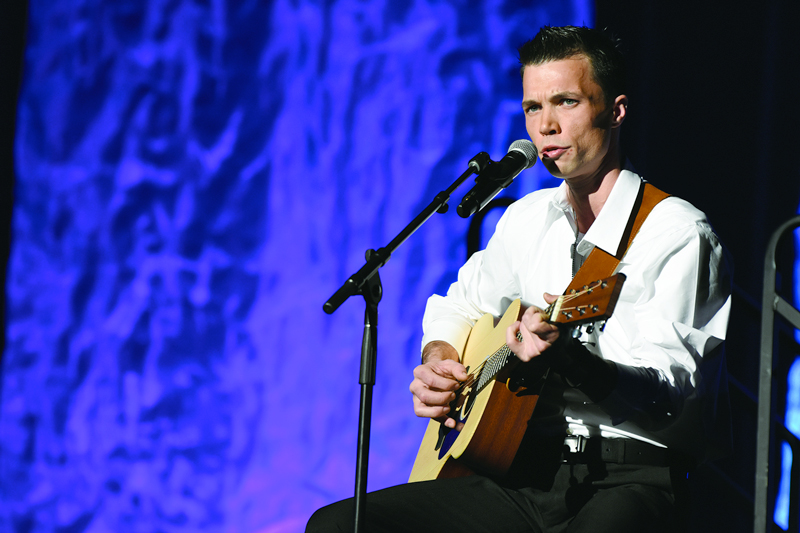
Jay Jamerson performs his rendition of Simple Man.
His motorized scooter had been damaged by the airlines on his way to the 2019 National Veterans Creative Arts Festival (NVCAF) in Kalamazoo, Mich. He began his week feeling frustrated, depressed, and sad. Satchell felt like he was a burden to those around him.
But he wasn’t a burden — not even close. ALA member and Veterans Affairs & Rehabilitation Eastern Division Chair Paulette Caron showed him that by doing what the ALA does best — helping our veterans every day, everywhere, in any way we can.
“To be able to get him his meal, to take him to his practices, to just talk to him, and see the smile on his face,” she said. “He’s just been thankful. But it was me who was thankful.”
As the week went on, Satchell’s scooter was fixed and he resumed life as normal, perfecting his guitar and vocal skills to perform Mustang Sally with his band at the stage show.
“He kept saying, ‘I don’t need help,’” Caron said. “However, if anyone said, ‘Do you need help?’ he said, ‘Yeah, but you need to go get Paulette.’ It was unbelievable. I thought he had just made an impact on me. But I was able to make an impact on him.”
Caron’s first time at the Festival was a life-changing experience, as it often is for most American Legion Auxiliary members. They quickly refer to veterans by first name, and many members develop a personal relationship with them. This event truly showcases the ALA’s mission in action — supporting our veterans and their families.
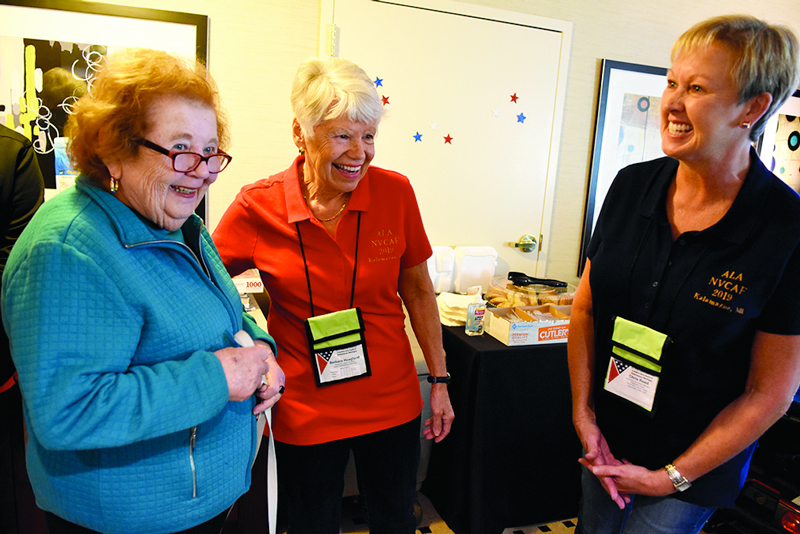
ALA volunteers help a caregiver in the hospitality suite.
Throughout the week, ALA members assisted with a wide range of duties, from registration to sewing, ironing, and steaming costumes, to helping with meals.
“We had great members out this week, and some who come every year so they can show the veterans that it isn’t just writing a check,” Caron said. “It is interacting, it’s personally thanking them, and it’s personally letting them know we are a co-presenter because we care.”
Members acted as an extra hand, a warm smile, a listening ear, and more. They saw firsthand the overwhelming positive impact the arts have on our nation’s veterans, giving them the chance to heal from visible and invisible wounds, days and even decades after their service.
“The art therapy happening in the VA facilities is crucial for these veterans to sustain a productive life,” Caron added. “This gives them a focus. It lets them know they have a way to bring joy to other people — that what they do matters.”
ALA members ended the week feeling blessed and thankful for such a rewarding experience of supporting those who serve.
“It was amazing. It was heartwarming,” Caron said. “It truly brings out why we do what we do.”
As co-presenters, and with members involved at both the local and national level, the National Veterans Creative Arts Festival truly demonstrates what the ALA is — a community of volunteers serving veterans, military, and their families.
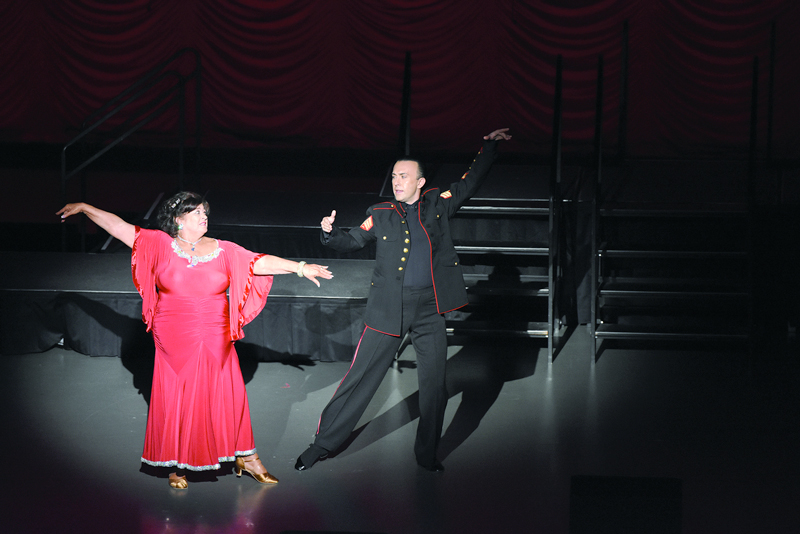
Mary Jean Houlahan performs a dance number with her dance partner, Sergh Aliev.
The event brings together creative veterans throughout the country who made it to the national level after competing at local VA facilities. There were 5,648 entries submitted into the local competitions, with over 3,500 entries judged at the national level in 150 categories of visual art, creative writing, dance, drama, and music.
The American Legion Auxiliary has been ‘doing what we do’ since 2000 when then-National President Kristine West wanted to focus on veterans as her special project, leading to the ALA becoming a sponsor of NVCAF. She asked the national presidents after her to also support the program — not as their special project, but to at least promote the program so the sponsorship could continue.
The commitment to the Festival 20 years ago was $75,000, and the ALA surpassed that.
“We went overboard, and everyone got behind the program,” West recalled.
She never dreamed the connection to this event would grow to what it is today with monetary and volunteer support to the level of the ALA as a co-presenter of the Festival since 2014 alongside the U.S. Department of Veterans Affairs.
“The ALA’s commitment and hands-on interactions help to enhance the experiences for veterans and their caregivers,” said Amy Kimbler, NVCAF director. “Most days, the ALA volunteers are the first faces the veterans see before breakfast and the last faces they see before going to bed after visiting the hospitality room. These interactions, these moments help to make the event memorable for all involved.”
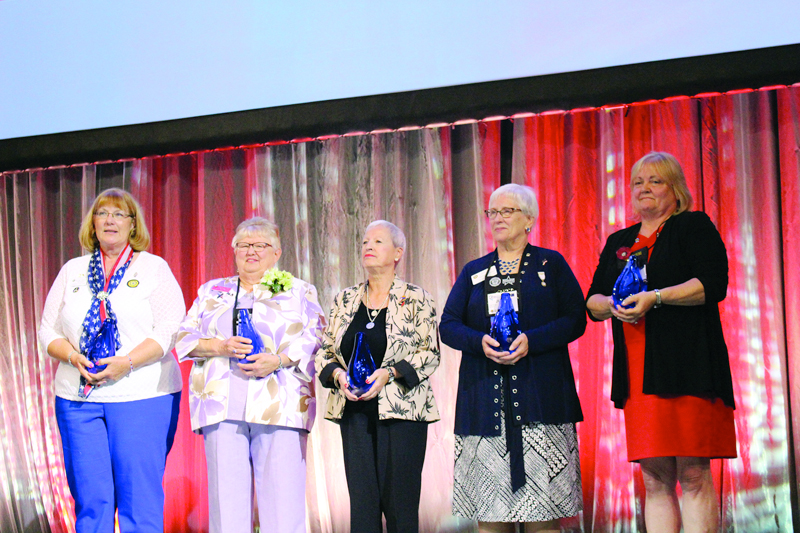
Veteran Carson Schaffer, left, talks to ALA leadership, including Past National President Kristine West, far right.
As we continue into our next century of service, West urges ALA members to continue to support the Festival, which in turn supports our mission.
“It’s great that the Festival has moved around across the country so more people can be exposed, and members can see it firsthand,” she said. “It just tugs at them, and you can see it.”
Knowing West’s connection to the Festival and 2019-2020 being a monumental time for the organization, ALA National President Nicole Clapp invited West to attend this year’s event as a guest of honor.
“When I was asked to be national president for our centennial, it was a simple decision for me to want to invite Kris to come and celebrate 20 years of her dedication, vision, and foresight so that we would be standing here today,” Clapp said.
Our organization has had a positive impact on this Festival for 20 years and counting. The ALA’s involvement in this event is crucial to our nation’s heroes and their health and well-being. Auxiliary magazine sat down with a few veterans who have been to five or more Festivals to talk about the difference it has made in their lives.
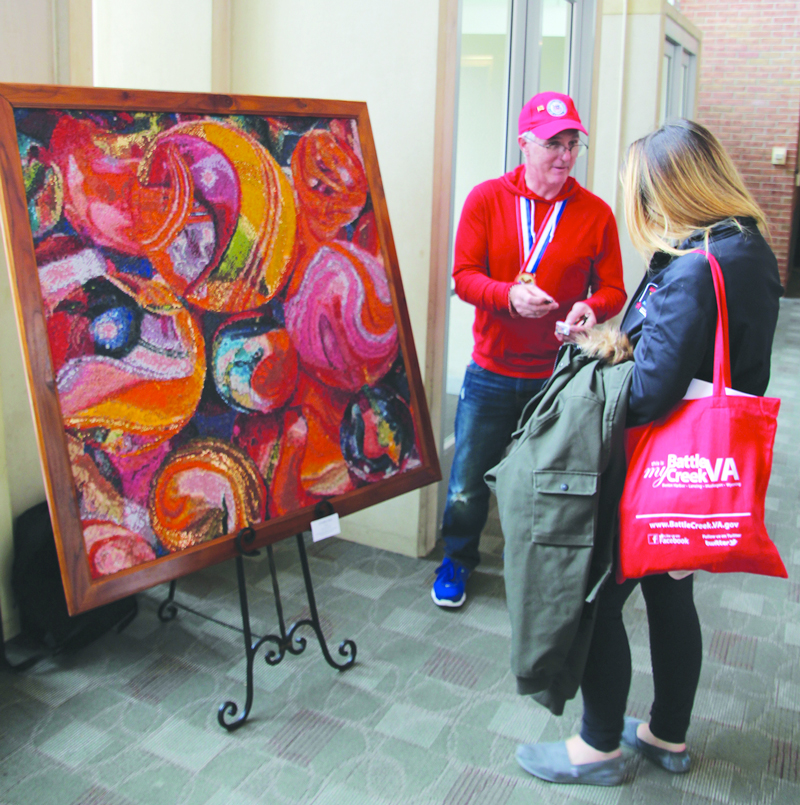
Branch of service: U.S. Navy
Festival participation: Visual artist
VA facility: Lakewood, Wash.
Number of times to the national Festival: 12
“Twenty-two veterans kill themselves per day, so there are 22 guys and ladies scattered throughout the whole project itself,” Connolly said, describing his collage made from recycled leather bags, jackets, and purses.
His art piece is appropriately titled 22 Hidden Faces. At first glance, it looks like a bunch of marbles.
Like most of the veterans who submit artwork for the Festival, the inspiration comes from personal topics. Connolly is no exception. A few of the faces are his shipmates.
“In the dead center of the piece, one I always point out, is one of my old buddies,” he said. “Every time I look at it, that’s all I see. I don’t see the rest. I know where they’re at. Some of them I hid really well from myself because it was too painful to see. His image I wanted to be dead center.”
Over the years, Connolly has toiled with different categories for the Festival, but he mainly focuses on leather. He got bored of doing the standard leather Western floral design and wanted to make use of all his scrap leather. He had a dream about making paint, but using leather. Connolly started with punching holes 3/16-inch size in a bag until all the color was gone and saved it as a pallet color. The rest is history.
Connolly enjoys what he does, but the arts are also a healing process for him. When he first started working on using paint from leather, he was going through rough times.
“I’d go back to my studio [after a counseling session] and let those emotions just pour out of my hands,” he said. “I was creating pieces that were really dark. They were really violent, or they were stuff I couldn’t even submit to the Festival; they were too painful. Some of them I don’t even look at. I put them away. I can’t even hang them on the wall. But as time went on, as I was working through all these issues and the things I needed to do for myself, it became more poignant where you could see all my artwork up on the wall. You see this dark period, and all the sudden it went from using black colors and browns to a scene of all these flowers with mountains in the sky.”
From then on, his artwork became more colorful, more bright, and more brilliant.
For veterans like Connolly, this Festival is a life-changing event.
“I don’t think I would be creating stuff without [the Festival] or having the vet center to work through these things,” he said. “I would just be doing the standard wallets, the standard purses — what normal leather crafters do. I would be entering that stuff, instead of me. Now I’m me.”
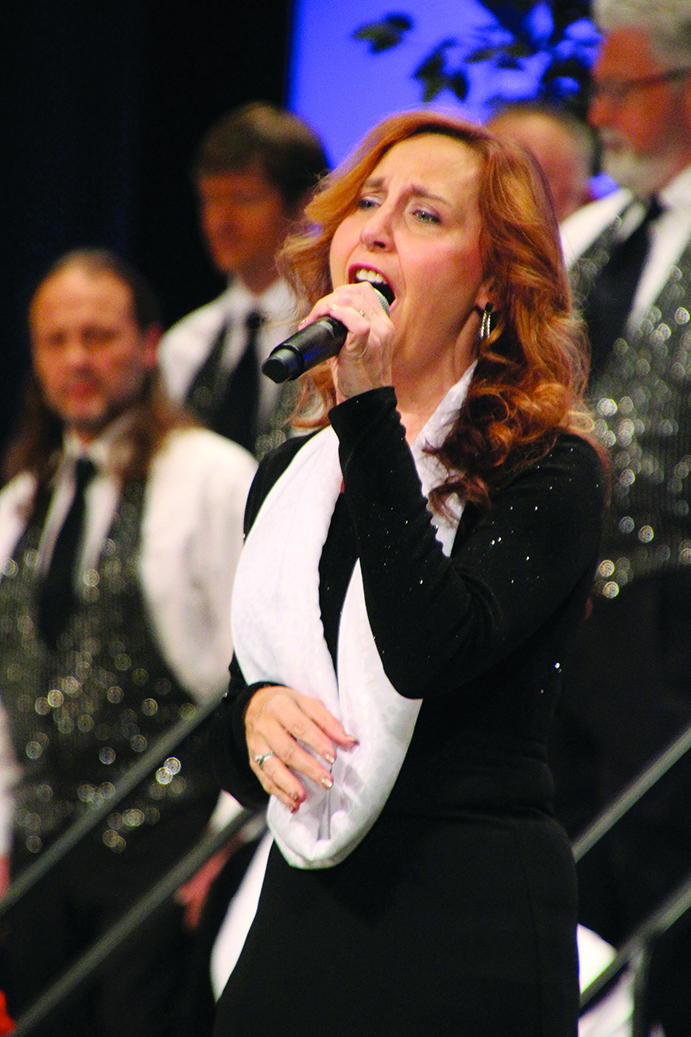
Branch of service: U.S. Air Force
Festival participation:Performer
VA facility: Bay Pines, Fla.
Number of times to the national Festival: 13+
“[Military service] was one of the proudest things I’ve ever done,” Heissler said. “I miss it. I miss the camaraderie. I think that’s why this Festival is important. There’s no one who understands you as well as your fellow brothers and sisters.”
Heissler has been a regular at the Festival over the years, mainly as a performer, both individually and in groups. Because she’s been a repeat, she’s able to help mentor other veterans.
This year, she made it to the national level with her group, Tones of Harmony. For those who have never been to the Festival, she said it’s “life changing for sure.”
“People from all over the states who have never met one another, they come together the first day, never sang together, and by the end of the week, you sound like you have been doing this forever together,” Heissler said. “My music therapist says there’s a little bit of magic.”
That magic is felt throughout the week by all involved with the event. For veterans, the week is about the journey of those seven days, not the destination.
“The stage show is actually the end product, and we all work for that, but the whole journey and experience between Monday and Monday is what you live for,” Heissler said.
The arts have helped her through the years on a number of levels, and she encourages others to find their passion.
“Being able to express yourself is one of the most important things for communicating,” she said. “I find it bridges the gap between what’s going on inside to the outside world. It helps when you don’t even realize it … I don’t know where I would be without [the arts].”
In addition to time spent performing with her fellow veterans, Heissler interacts with members of the American Legion Auxiliary at meals and social events. She actually joined the organization after her first national Festival.
An ALA member approached her about membership, and she and her daughters joined. The Auxiliary further helped Heissler’s family when she got really sick and was being evaluated for a heart transplant. The family was getting close to losing their house. A fellow ALA member told her about the Auxiliary Emergency Fund, and the family applied and received the grant.
“The ALA stepped up and helped us take care of our bills for two or three months just to bridge that gap until we could get back on our feet again,” she said. “It wasn’t just because of the Festival — we know they are there for the veterans. We’ve had to have their help.”
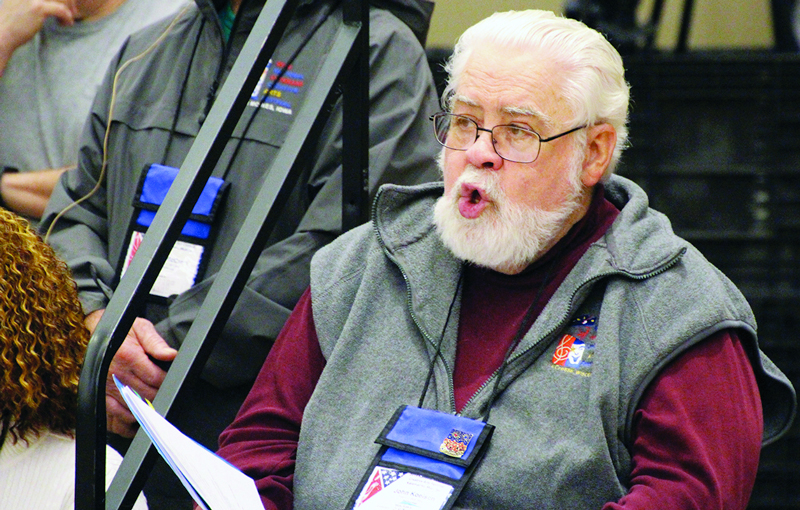
Branch of service: U.S. Army
Festival participation: Performer
VA facility: Salem, Va.
Number of times to the national Festival: 6
Koelsch started off entering the Veterans Creative Arts Festival local contest as a writer and has developed his abilities to include performer as well.
After submitting creative writing pieces, Koelsch turned to drama. He is working toward a medal at the local level in each division.
This year, he submitted a group piece to his local Festival, with each individual talking about the ‘things we brought home’ — the feelings, thoughts, and ideas surrounding deployment.
“It’s terribly emotional,” he said. “Generally, I’m not someone who gets emotional. It hit a chord.”
The Festival and the challenges and triumphs it presents help bring the veterans closer together throughout the week, mimicking the bonding and camaraderie they experienced while in uniform.
“You are able to open up because you are safe here,” he said. “This is where you don’t have to worry. If you behave a certain way, everyone else will understand. They’ve done something similar.”
There are many veterans who attend the Festival who have post-traumatic stress disorder. Koelsch is one of them.
“This has been very helpful,” he said. “I can just be myself and not be sensitive about it … there’s nothing better for veterans with PTSD than creativity.”
Creativity continues at the national Festival where there’s no competition — everyone already has a gold medal — but now they have a job to do.
“You’re really here representing every veteran there is,” Koelsch said. “We have a responsibility to honor that.”
He offers advice to first-time participants.
“It’s going to be chaos,” he said. “You need to go in and relax, and participate, and soak it up. By the end of the week, your life will change.”
Once he started attending, Koelsch worked to get others to compete at the local level, knowing how beneficial it is. There are at least 10 people who have come to the national Festival because of him.
“It just fulfills a space in me that’s good, that’s very positive,” he said. “I enjoy watching people come here and blossom.”
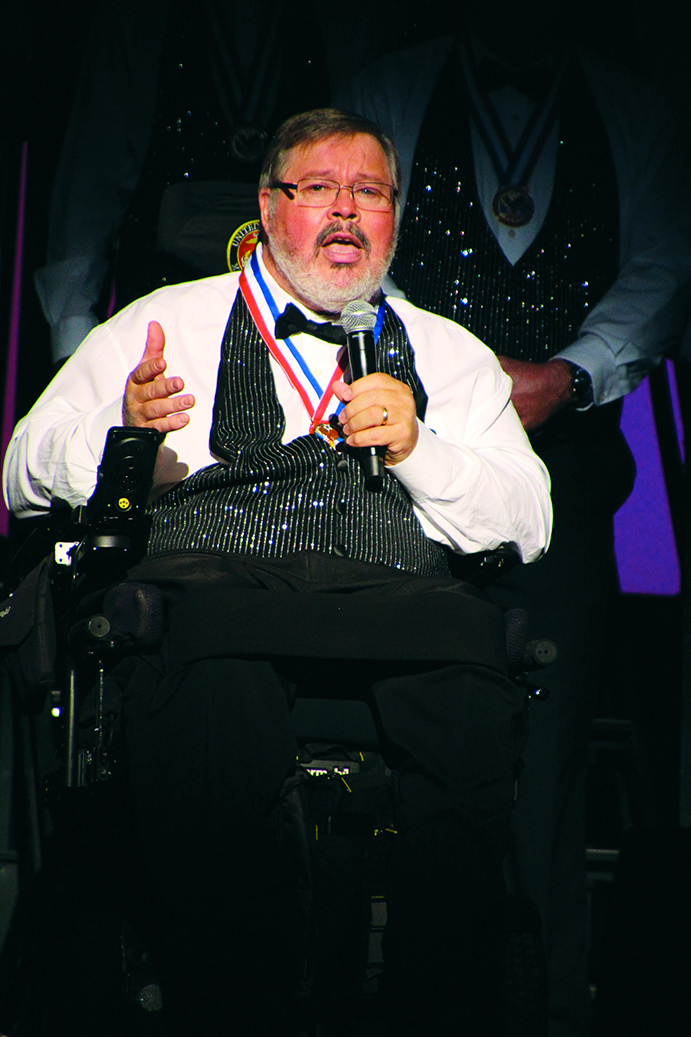
Branch of service: U.S. Marine Corps
Festival participation: Performer
VA facility: St. Paul, Minn.
Number of times to the national Festival: 25
Stang’s first Festival was in 1993, and he’s pretty much attended ever since.
He has always entered as a performing artist, first starting off submitting solo entries. Over the years, it has been more difficult to get a gold medal because the competition in that category has increased. He then began doing wheelchair dances with his wife and other friends, then branched out to duets.
Stang enjoys coming back each year and seeing familiar faces.
“It’s like seeing your relatives at a family reunion once a year,” he said. “That’s what is enjoyable to me.”
Participation in the Festival has led Stang to other performing opportunities outside of NVCAF.
“All because of the creative arts, I was able to do other things because I got invited,” he said. “It opened up some doors. Things I would have never had the chance to do.”
Like other veterans at the Festival, Stang believes in the power of the arts to heal and make a difference.
“The poetry and the artwork, where people who are really struggling maybe mentally and physically in their art or their words, you really get a sense of what they have gone through, what they are going through,” he said. “It’s more of the therapeutic value … I think when you go to the local VA and the local art shows, them explaining their art and their ordeal and their life and what they’ve gone through — it’s just amazing how they can do what they do.”
Having participated for 25 years, Stang offers his own advice to someone who wants to enter at the local level for the first time.
“Find a song you really enjoy if you are performing and that you think other people would enjoy,” he said. “You have that connection with a familiar song. You will sing it much better than something that’s just popular.”
Also, being a repeat performer, Stang has tips for those who want to return more than once.
“Anything that’s a solo is going to have heavier competition,” he said. “If you can get into things like Broadway or other categories that aren’t as popular, you can still end up getting a gold medal. They may not put it in the show, but they might invite you to be a chorus member, like I did this year.”
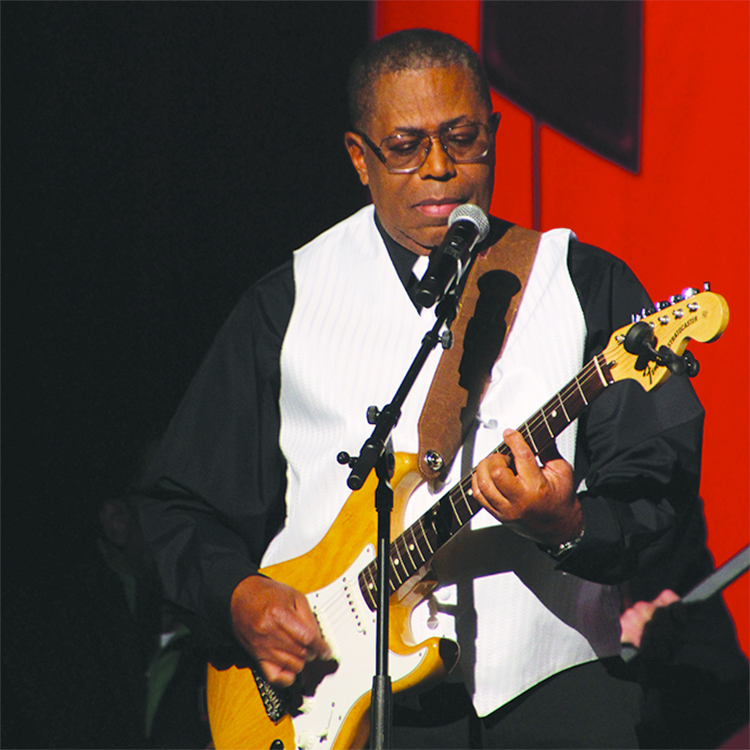.jpg?lang=en-US)
Branch of service: U.S. Air Force
Festival participation: Performer
VA facility: Aurora, Colo.
Number of times to the national Festival: 5
“What I found with our music, it brings us [veterans] together,” Taylor said about the healing power of the arts. “It’s kind of therapeutic. You are on the same level; you relate to them. They can tell you their problems, and you can tell them the problems you have. It’s a method of socialization by being with other veterans versus being isolated by yourself. That’s why people love this week so much to be amongst other veterans.”
Having attended multiple Festivals, Taylor has learned how to make the week a success through experience of knowing what to expect each day.
“It’s like a marathon versus a sprint,” he said. “The first year I went, I almost lost my voice before the regular performance because I was singing full out. Now they tell newcomers to take your time, pace yourselves.”
Like many veterans, day one is often a favorite.
“Seeing old friends you haven’t seen for quite a while [is one of my favorite parts],” he said. “You have the time to meet and talk with them.”
This year, Taylor, along with veteran Gary Satchell, entered the national competition with his band, Vets in Tune, who played Mustang Sally. He was excited because he had always come to the Festival as part of the chorus, not performing as an individual act with his band.
Taking part in yet another Festival, Taylor knows how beneficial the arts are.
“All veterans should take advantage of the arts,” he said. “The more publicity we give to it, the more exposure we will get, and more veterans will participate in it.”
Performers arrived Monday and were busy throughout the week with rehearsals — striving to improve, singing together on the beat, and practicing individual acts to prepare for the main stage show.
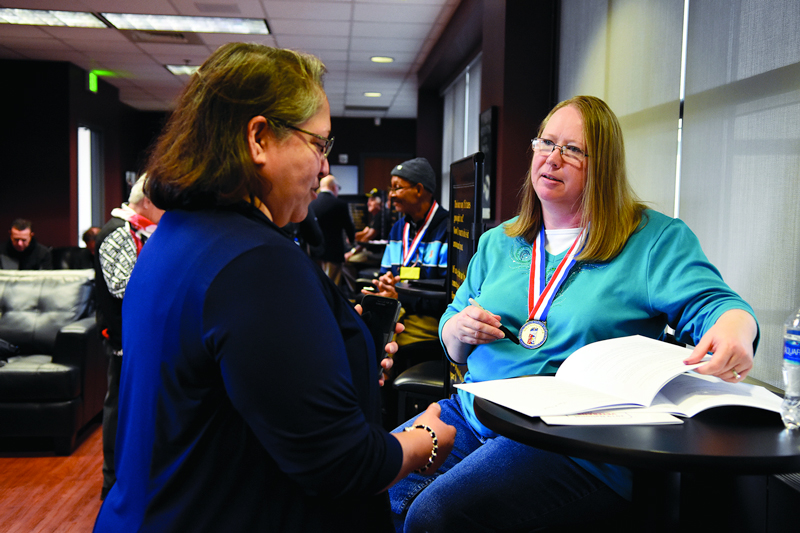
Writer Nina Pervel discusses the inspiration behind her work.
Artists and writers arrived Wednesday, quickly bonding over their shared military experiences. They participated in art and writing workshops, learning different skills to perfect their craft. The workshops led to lots of laughing, sharing of ideas, and making friends.
The week was emotional, with many participants saying the arts helped them get through tough times as a powerful healer, no matter what may be ailing them physically, emotionally, and mentally. During the Festival, artists received an opportunity to briefly talk about their works during the week — one getting so emotional that fellow veterans in the crowd stood up and clapped to show support. At the Writers Showcase, one writer got so choked up with emotion reading their works that someone else stepped in to finish the story.
As the saying goes, it takes a village. From veterans to staff and volunteers to caregivers to donors, the Festival truly is a labor of love for all involved in the event’s success.
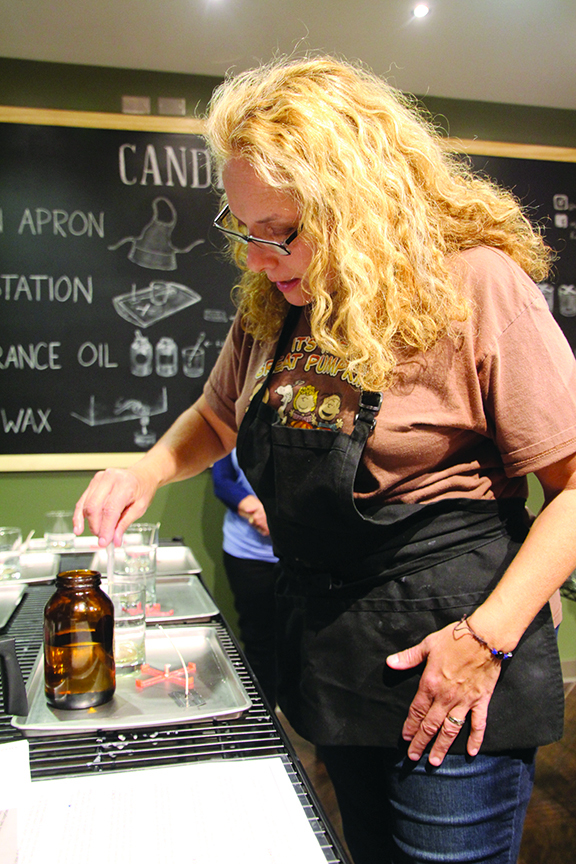
Caregiver Janine Dougherty mixes the oil for her candle.
Throughout the week, caregivers are supporting their veterans at rehearsals, art workshops, and more. In addition to supporting veterans, the American Legion Auxiliary shared that same compassion for caregivers at the Festival by treating them to special outings — making candles and touring a local museum.
Bill Heissler attended with his wife, Rebecca (the U.S. Air Force veteran previously featured in this article).
“When she gets in practice, I have to watch her because she won’t eat right; she won’t drink right,” he said. “She will be sitting up there singing her heart out and slowly tilting to one side or the other because she’s crashing and doesn’t even realize it. I keep her where she needs to be.”
Having experience as a caregiver, Bill Heissler offers advice for others who may be in that same situation or will someday be a caregiver.
“Patience and understanding,” he said. “You are going to hear the same thing over and over again. Whatever is ailing them, you’re going to hear it. You have to take yourself out of the equation … you learn to roll with the punches. And just be there for each other.”
Getting the opportunity to participate in caregiver-focused activities during the week made Bill realize he was not alone, and that others face similar difficulties.
“It’s challenging, but at the same time, when you watch them and they are having good days, it’s all worth it,” he said.
An event of this magnitude that supports veterans and their families wouldn’t be possible without the monetary support of its many donors. One of those donors is ALA member Bobbi Cox of Unit 291 in Newport Harbor, Calif. She has been a member of the Auxiliary for about 35 years and has been donating for nearly a decade.
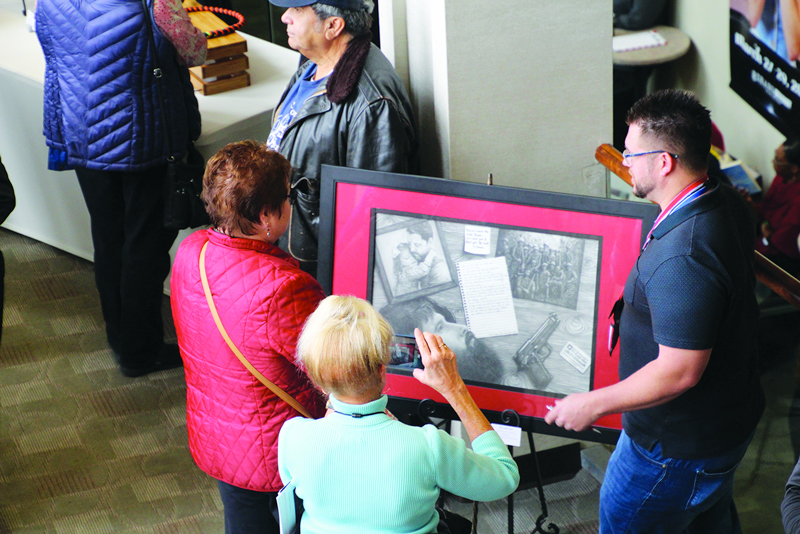
ALA member Bobbi Cox takes a photo of Brian Small’s artwork.
Her interest in the Festival is twofold — it brings together two things she cares about: veterans and dance. Cox said she was inspired by the Festival right away.
“It was this merger of the performing arts and the value of the arts and education and expression and the human condition with veterans,” she said. “It’s a perfect match. It’s incredibly wonderful.”
It is meaningful for Cox to see what a difference her monetary contribution is making in the lives of our nation’s veterans.
“It makes you want to do more and better,” she said. “It’s very stimulating and satisfying. The arts are what make us human.”
As a regular gold medal sponsor of the event, Cox offers a tip to those who want to donate, but perhaps can’t give that much.
“Any amount of money, you add it up, and it becomes significant,” she said.
To donate to the Veterans Creative Arts Festival, visit www.ALAforVeterans.org/donate and select “American Legion Auxiliary Foundation Natl/Local Veterans Creative Arts Festival(s).”
Veterans, ALA volunteers, and VA staff all benefit from the Festival, both emotionally and mentally, leaving the week with newfound friends, experiences, and an even greater appreciation of the value of the arts.
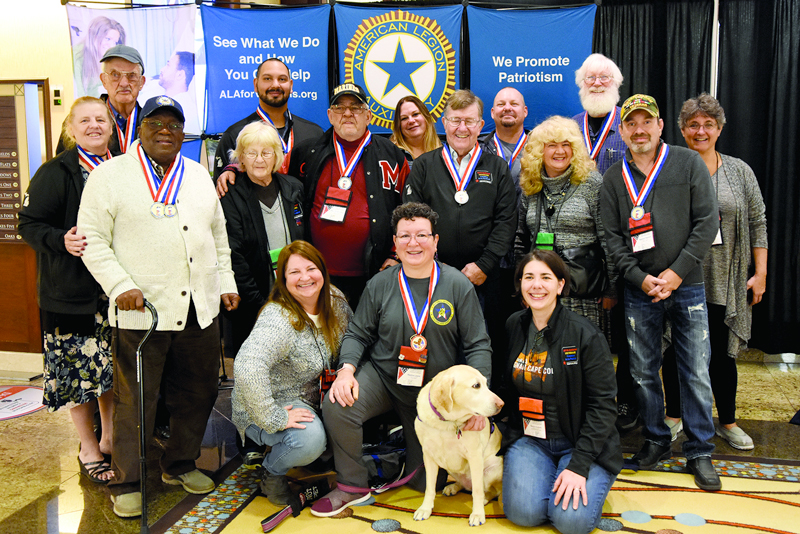
Participants pose in front of the ALA banner.
As co-presenters, and with members involved at both the local and national level, this event truly demonstrates what the ALA is — a community of volunteers serving veterans, military, and their families.
“Anybody who spent the week here, you can’t walk away without a feeling of even more gratitude,” ALA member Paulette Caron said, citing the impact Gary Satchell and other veterans had on her. “It was absolutely just an experience of a lifetime.”
By Sara Fowler, Staff Writer
Want to know more about this event? View a selection of the artwork on page 32 of Auxiliary magazine and learn about NVCAF Director Amy Kimbler.
This article first appeared in the February Auxiliary magazine.
In the spirit of Service, Not Self, the mission of the American Legion Auxiliary is to support The American Legion and to honor the sacrifice of those who serve by enhancing the lives of our veterans, military, and their families, both at home and abroad. For God and Country, we advocate for veterans, educate our citizens, mentor youth, and promote patriotism, good citizenship, peace and security.